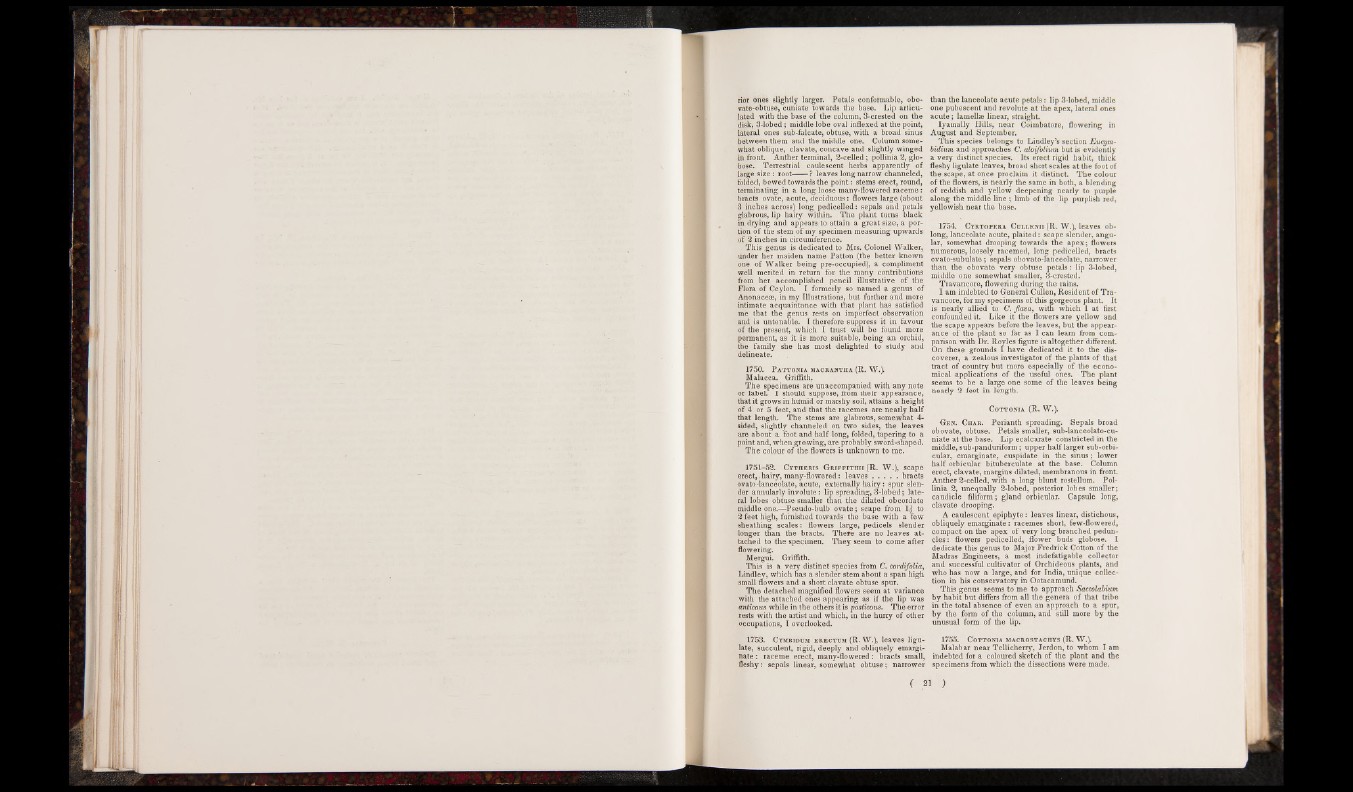
rior ones slightly larger. Petals conformable, obo-
vate-obtuse, cuniate towards the base. Lip articulated
with the base of the column, 3-crested on the
disk, 3-lobed; middle lobe oval indexed at the point,
lateral ones sub-falcate, obtuse, with a broad sinus
between them and the middle one. Column somewhat
oblique, clavate, concave and slightly winged
in front. Anther terminal, 2-celled; pollinia 2, globose.
Terrestrial caulescent herbs apparently of
large size: root------? leaves long narrow channeled,
folded, bowed towards the point: stems erect, round,
terminating in a long loose many-flowered raceme:
bracts ovate, acute, deciduous: flowers large (about
3 inches across) long pedicelled: sepals and petals
glabrous, lip hairy within. The plant turns black
in drying and appears to attain a great size, a portion
of the stem of my specimen measuring upwards
of 2 inches in circumference.
This .genus is dedicated to Mrs. Colonel Walker,
under her maiden name Patton (the better known
one of Walker being pre-occupied), a compliment
well merited in return for the many contributions
from her accomplished pencil illustrative of the
Flora of Ceylon. I formerly so named a genus of
Anonacese, in my Illustrations, but further and more
intimate acquaintance with that plant has satisfied
me that the genus rests on imperfect observation
and is untenable. I therefore suppress it in favour
of the present, which I trust will be found more
permanent, as it is more ,suitable, being an orchid,
the family she has most delighted to study and
delineate.
1750. Pattonia macrantha (R. W.).
Malacca. Griffith.
The specimens are unaccompanied with any note
or label. I should suppose, from their appearance,
that it grows in humid or marshy soil, attains a height
of 4 or 5 feet, and that the racemes are nearly half
that length. The stems are glabrous, somewhat 4-
sided, slightly channeled on two sides, the leaves
are about a foot and half long, folded, tapering to a
point and, when growing, are probably sword-shaped.
The colour of the flowers is unknown to me.
1751-52. Cytheris Griffithii (R. W.), scape
erect,.hairy, many-flowered: le a v e s .............bracts
ovato-lanceolate, acute, externally hairy: spur slender
annularly involute: lip spreading, 3-lobed; lateral
lobes obtuse smaller than the dilated obcordate
middle one.—Pseudo-bulb ovate; scape from 1^ to
2 feet high, furnished towards the base with a few
sheathing scales: flowers large, pedicels slender
longer than the bracts. There are no leaves attached
to the specimen. They seem to come after
flowering.
M’ergui. Griffith.
This is a very distinct species from C. cordifolia,
Lindley, which has a slender stem about a span high
small flowers and a short clavate obtuse spur.
The detached magnified flowers seem at variance
with the attached ones appearing as if the lip was
anticous while in the others it is posticous. The error
rests with the artist and which, in the hurry of other
occupations, I overlooked.
1753. Cymbidum erectum (R. W.), leaves ligu-
late, succulent, rigid, deeply and obliquely emargi-
n a te : raceme erect, many-flowered: bracts small,
fleshy: sepals linear, somewhat obtuse; narrower
than the lanceolate acute petals: lip 3-lobed, middle
one pubescent and revolute at the apex, lateral ones
acute; lamellae linear, straight.
lyamally Hills, near Coimbatore, flowering in
August and September.
This species belongs to Lindley’s section Eucym-
bidium and approaches C. aloifolium but is evidently
a very distinct species. Its erect rigid habit, thick
fleshy ligulate leaves, broad short scales at the foot of
the scape, at once proclaim it distinct. The colour
of the flowers, is nearly the same in both, a blending
of reddish and yellow deepening nearly to purple
along the middle line ; limb of the lip purplish red,
yellowish near the base.
1754. Cyrtopera Cullenii (R. W.), leaves oblong,
lanceolate acute, plaited: scape slender, angular,
somewhat drooping towards the apex; flowers
numerous, loosely racemed, long pedicelled, bracts
ovato-subulate; sepals obovato-lanceolate, narrower
than the obovate very obtuse petals: lip 3-lobed,
middle one somewhat smaller, 3-crested.
Travancore, flowering during the rains.
I am indebted to General Cullen, Resident of Travancore,
for my specimens of this gorgeous p lan t It
is nearly allied to C. Jlava, with which 1 at first
confounded it. Like it the flowers are yellow and
the scape appears before the leaves, but the appearance
of the plant so far as I can learn from comparison
with Dr. Royles figure is altogether different.
On these grounds I have dedicated it to the discoverer,
a zealous investigator of the plants of that
tract of country but more especially of the economical
applications of the useful ones. The plant
seems to be a large one some of the leaves being
nearly 2 feet in length.
Cottonia (R. W.).
Gen. Char. Perianth spreading. Sepals broad
obovate, obtuse. Petals smaller, sub-lanceolato-cu-
niate at the base. Lip ecalcarate constricted in the
middle, sub-panduriform; upper half larger sub-orbicular,
emarginate, cuspidate in the sinus; lower
half orbicular bituberculate at the base. Column
erect, clavate, margins dilated, membranous in front.
Anther 2-celled, with a long blunt rostellum. Pollinia
2, unequally 2-lobed, posterior lobes smaller;
caudicle filiform; gland orbicular. Capsule long,
clavate drooping.
A caulescent epiphyte: leaves linear, distichous,
obliquely emarginate: racemes short, few-flowered,
compact on the apex of very long branched peduncles:
flowers pedicelled, flower buds globose. I
dedicate this genus to Major Fredrick Cotton of the
Madras Engineers, a most indefatigable collector
and successful cultivator of Orchideous plants, and
who has now a large, and for India, unique collection
in his conservatory in Ootacamund.
This genus seems to me to approach Saccolabium
by habit but differs from all the genera of that tribe
in the total absence of even an approach to a spur,
by the form of the column, and still more by the
unusual form of the lip.
1755. Cottonia macrostaghys (R. W.).
Malabar near Tellicherry, Jerdon, to whom I am
indebted for a coloured sketch of the plant and the
specimens from which the dissections were made.